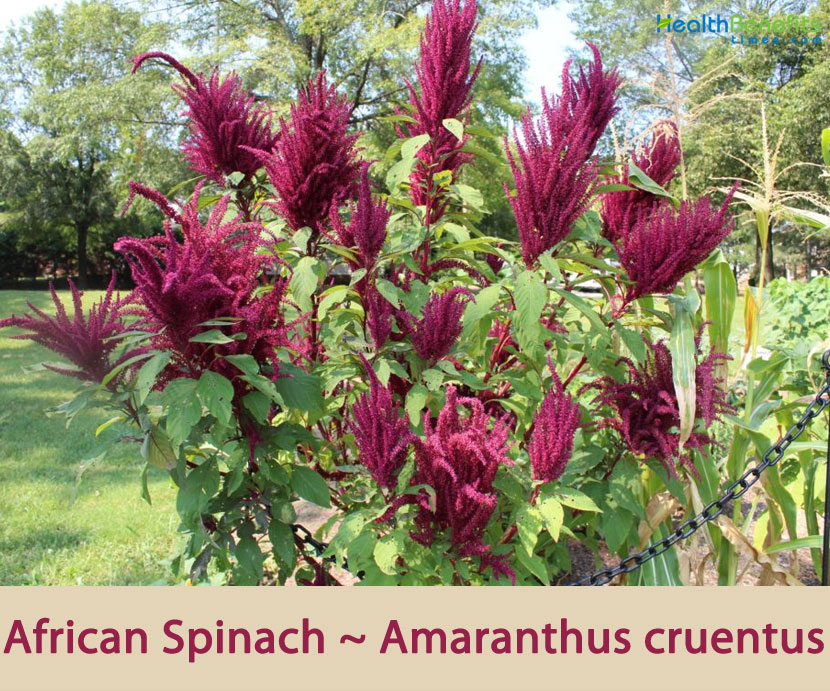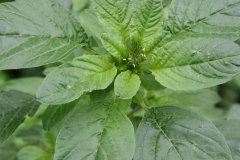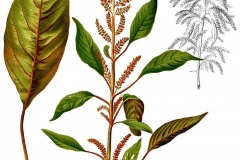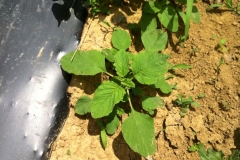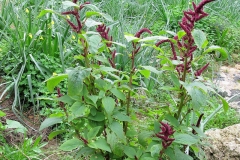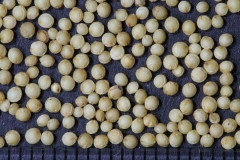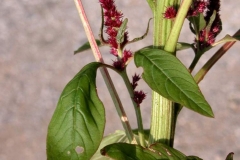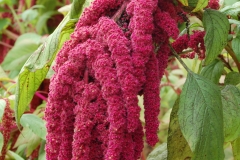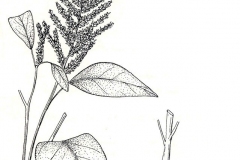| African Spinach Quick Facts | |
|---|---|
| Name: | African Spinach |
| Scientific Name: | Amaranthus cruentus |
| Origin | Central-South America specifically Peru |
| Colors | White, pink, through gold and brown to black (Seed) |
| Shapes | Broadly lenticular to elliptic-lenticular, 1.2-1.6 mm diam., smooth or indistinctly punctate |
| Taste | Sweet |
| Health benefits | Healthy Heart, Maintains Blood Pressure Levels, Improves Digestion, Improves Eyesight, Good for gastric ulcers, Healthy Bone, Prevents Anemia, Improves Metabolism, Promotes Healthy brain, Good for Skin, Good for Weight Loss, Prevents Cancer |
| Name | African Spinach |
|---|---|
| Scientific Name | Amaranthus cruentus |
| Native | Central-South America specifically Peru |
| Common Names | African-spinach, Indian-spinach, Sudan-spinach, blood amaranth, bush greens, caterpillar amaranth, panicled amaranth, purple amaranth, red amaranth, red shank, wild amaranth, grain amaranth, velvet flower |
| Name in Other Languages | Albanian: Nena e apur, nenë Arabic: Qatifat damawia (قطيفة دموية) Australia: Redshank Belarusian: Aksamitnik miaciolčaty (аксамітнік мяцёлчаты) Catalan: Marxant vermell Chinese: Lao ya gu (老鸦谷), Fan sui xian (繁 穗苋) Croatian: Cviet rumeni Cuba: Bledo francés, globo de oro, moco de pavo Czech Republic: Laskavec červenoklasý, laskavec krvavý, laskavec zvrhlý latnatý Denmark: Rød amarant Dominican Republic: Bledo, zépina English: African spinach, Blood amaranth, Grain amaranth, Mexican grain amaranth, Red amaranth, Purple amaranth, bush greens, caterpillar amaranth, Indian Spinach, panicled spinach, red shank, sudan spinach, wild amaranth, Cape pigweed, prince’s feather, Sudan-spinach, Panicled amaranth Estonian: Pööris-rebashein, Verev rebashein Finland: Puppurarevonhäntä Finnish: Vaihtelevarevonhäntä, purppurarevonhäntä French: Amarante paniculée, Epinard du Soudan, amarante, amarante étalée, queue de renard, brède de Malabar, amarante couleur-de-sang, amarante rouge, amarante sanglante German: Fuchsschwanz, Rispen-Fuchsschwanz, rispiger Fuchsschwanz, Ausgebreiteter Amarant, Ausgebreiteter Fuchsschwanz, Rispen- Amarant, Gartenfuchsschwanz, Katzenschwanz, Rispenamarant, Blutroter Amarant, Blutroter Bastard-Amarant Greek: Glintos Haiti: Epanard Hindi: Chuamarsa, Ganhar, Rajgeera, chaulai (चौलाई), lal sag (लाल साग), ramdana (रामदाना) Hebrew: Yarbuz yerok-shibbolet (יַרְבּוּז יְרֹק-שִׁבֹּלֶת) Hungarian: Sárga disznóparéj, bíbor disznóparéj, terpedt disznóparéj, Bíbor amaranth, Karcsú disznóparéj Italian: Amaranto cruento, Amaranto rosso, amaranto paniculato Japanese: Amarantsusu kuruentasu (アマランツス ・ ク ルエ ンタス ), Fuji geitou (フ ジゲイトウ), Sugimori geitou ( スギモリゲイトウ), hosoaogeito Kannada: Rajgiri (ರಾಜಗಿರಿ) Kashmiri: bustan afroz (बुस्तान अफ्रोज़), mawal (मवल्) Konkani: Rajgiri (राजगिरि) Korean: Ga neun teol bi reum (가는털비름), seonjulmaendeulami (선줄맨드라미) Latvian: Skarainais amarants Lithuania: Raibasis burnotis, šluotinis burnotis Marathi:, Rajgira (राजगिरा), shravani maath (श्रावणी माठ) Netherlands: Graanamarant Poland: Szarłat krwisty Polish: Szarłat wiechowaty, szarłat wyniosły, Szarłat prosty Portuguese: Amarantos-a-grãos, Caruru-roxo, amaranto, bredo, caruru-branco, bredo-vermelho, caruru-vermelho Puerto Rico: Gusano Punjabi: Taj khurus (ਤਜ ਖੁਰੁਸ) Russian: Shchiritsa gibridnaia (Щирица гибридная), Shchiritsa metel’chataia (Щирица метельчатая), amarant bagryanyi (амарант багряный), amarant metel’chatyy (амарант метельчатый), shchiritsa bagryanaya (щирица багряная), shchiritsa krovavo-krasnaya (щирица кроваво-красная) Sanskrit: Rahadri, rajagiri (राजगिरि) Slovak: Láskavec metlinatý, láskavec rozkladitý, Slovenian: Izrodni ščir, Košati ščir, košati ščirovke Spanish: Bledo , achita, amaranto; cola de zorro, gusano, moco de pavo, Bledo crestagallo, Amarant, Blet, Blet punxent, Marxant, Alegría, Huautli Swedish: Blodamarant Tamil: Mulai kkirai, Mullukkirai, pu-n-kirai (பூங்கீரை) Tatar: Әтәч кикриге Turkish: Horozibiği Upper Sorbian: Wisaty šćěrjenc Urdu: گل کيش gul-kesh UK: Indian spinach Ukrainian: shchyrytsya volotysta (щириця волотиста), shchyrytsya zakryvavlena (щириця закривавлена) USA: Blood amaranth, caterpillar amaranth, purple amaranth Welsh: Blodyn Amor Porffor |
| Plant Growth Habit | Annual, herbaceous, invasive, short-lived, fast-growing plant |
| Plant Size | Up to 2 m (6 ft.) in height |
| Root | Plant produces one dominant, large, central root (tap root) |
| Stem | Erect, green or reddish purple, stout, branched, angular, glabrous or thinly to moderately furnished with multicellular hairs. Thick stems are often 0.1 to 2.0 m in height, ribbed, and red dyed. |
| Leaf | Arranged spirally, simple, without stipules, long-petiolate; lamina broadly lanceolate to rhombic-ovate, 2–18 cm long and 2–15 cm wide, attenuate or shortly cuneate at base, obtuse to subacute at apex, mucronate, entire, glabrous to sparsely pilose and pinnately veined. |
| Flowering season | July to September |
| Inflorescence | Inflorescence large and complex, consisting of numerous agglomerated cymes arranged in axillary and terminal racemes and spikes, the terminal one up to 45 cm long, usually with many lateral, perpendicular, thin branches; bracts 2–3 mm long, with a long awn. |
| Flower | Unisexual, subsessile, with 5 tepals 1–2 mm long; male flowers with 5 stamens c. 1 mm long; female flowers with superior, 1-celled ovary crowned by 3 stigmas |
| Seed Shape & Size | Broadly lenticular to elliptic-lenticular, 1.2-1.6 mm diam., smooth or indistinctly punctate |
| Seed Color | Usually white or ivory, with reddish or yellowish tint, sometimes dark brown to dark reddish brown |
| Propagation | By Seed |
| Taste | Sweet |
| Plant Parts Used | Leaves, seed |
| Season | August to September |
| Health Benefits |
|
Plant Description
African spinach is an annual, invasive, short-lived, fast-growing herbaceous plant that normally grows up to 2 m (6 ft.) in height. Normally plant reproduces only by seeds and has a short growing period of 4–6 weeks. It produces one dominant, large, central root (tap root). Stems are erect, green or reddish purple, stout, branched, angular, glabrous or thinly to moderately furnished with multicellular hairs. Thick stems are often 0.1 to 2.0 m in height, ribbed, and red dyed. Leaves are arranged spirally, simple, without stipules, long-petiolate. Lamina is broadly lanceolate to rhombic-ovate, 2–18 cm long and 2–15 cm wide, attenuate or shortly cuneate at base, obtuse to subacute at apex, mucronate, entire, glabrous to sparsely pilose and pinnately veined. Small fine hairs cover leaf and stem surfaces.
Flower
Several unisexual flowers are green and form finger-like spikes with long and dense terminal panicle and axillary spikes below. The terminal spike is often lax. There are 5 tepal segments, which are lanceolate, acute, 2-3 mm long, with a sharp and long tip, causing the inflorescence to feel distinctly prickly. Five, 1 mm long stamens form a male flower, while the female flower is a 1-celled ovary crowned by 3 stigmas. At maturity, the whole plant may be reddish. The large and complex inflorescence consists of numerous concentrated cymes arranged axillary, ended with racemes and spikes. The top one, with numerous laterals, is perpendicular, with thin branches up to 45 cm long. There 2-3 mm long bracts. The inflorescence is more than 50 cm long, characterized by high color variability. Flowering normally takes place in between July to September.
Fruit/Seed
Each of them produces about 50 000 seeds in round or more often in lenticular shape, 1-1.5 mm in diameter, shiny, and dark brown. The mass of 1000 seeds is around 0.6-1.0 g. Grains are lenticular, with a color that varies from white, pink, through gold and brown to black. The coat of the seed is smooth and thin. The germ is campylotropous, which is caused by the shape of the seed and they are bent down and surround the perisperm like a ring. The perisperm is the main seed storage. Endosperm is present only in the micropylar area of the seed.
Health Benefits of African Spinach
Listed below are some of the popular health benefits of African Spinach
1. Healthy Heart
Consuming African spinach helps in preventing a heart attack due to its richness in lutein that prevents the thickening of the walls arteries, thus preventing atherosclerosis that is caused due to hardening of the arteries. Also proteins aids in reducing the cholesterol and other fat deposits in the blood vessels.
It consists of a high content of nitrite that helps in preventing the occurrence of heart attack and also prevents the body from heart diseases associated with fat deposition. Thus the intake of spinach regularly contributes to a healthy heart.
2. Maintains Blood Pressure Levels
African spinach consists of very low content of sodium and high content of potassium which is very beneficial for people suffering from high blood pressure, as potassium lowers and sodium increases the blood pressure.
Similarly, the presence of foliate in spinach contributes to the reduction of hypertension and relaxes the blood vessels, thus maintaining the proper flow of blood. Therefore consuming African spinach regularly helps in maintaining good blood pressure levels.
3. Improves Digestion
African spinach consists of good amount of fiber and water content, and also calories free making it very good for the digestive tract. This vegetable helps in digestion, prevent or relieve constipation as well. Including African spinach to your daily meal helps a lot in promoting a healthy digestive tract.
4. Improves Eyesight
African spinach contain important antioxidants such as lutein, xanthene, and beta-carotene that help to improve eyesight and prevent the eyes from the effect of ultraviolet rays that can cause cataracts as well as vitamin A deficiency.
Also, zeaxanthin and lutein contained in African spinach aids in preventing cataracts and macular degeneration that can lead to blindness. Regular consumption of African spinach helps greatly protecting our eyes from the damage caused by sunlight, thus promoting a healthy eye.
5. Good for gastric ulcers
African spinach consists of some anti-ulcer properties that help to prevent the body from gastric ulcers. Research has shown that spinach and some other vegetables are capable of protecting the mucous membrane of the stomach, thus reducing the occurrence of gastric ulcers.
Also, the glycoglycerolipids contained in spinach helps in increasing the strength of the digestive tract lining, thus preventing unwanted inflammation in the body. Therefore consuming spinach daily will help in protecting the body from a gastric ulcer.
6. Healthy Bone
Regular intake of African spinach helps to improve skeletal and bone health because it consists of certain minerals related with bone health such as calcium and magnesium.
It is also a good source of vitamin K that is liable for retaining calcium in the bone matrix, thus resulting in bone mineralization. It is also rich in minerals like zinc, phosphorus, copper, manganese, and magnesium that help in the building of a strong bone and preventing osteoporosis. These minerals are also important for maintaining 8. healthy nails and teeth. Consume African spinach today for a strong and healthy bone.
7. Prevents Anemia
Consuming African spinach regularly can help in preventing anemia due to its rich iron content. As we all know that iron deficiency leads to anemia. Iron is essential for menstruating women and growing children. It provides fewer calories and is free from cholesterol and fat.
Iron is essential in the body for good energy, as it is a component of hemoglobin which transfers oxygen to the body cells. Sufficient intake of iron-rich foods can go a long way in the prevention of anemia and consuming regularly can be of help.
8. Improves Metabolism
African spinach helps in metabolism improvement because it consists of the amount of protein needed in the body which the enzymes convert into amino acid which in turn gives normal structure to the body cells. Also, the reformed mammal protein helps in the development and growth of muscle.
They help in increasing the body’s healing ability and provide a boost to the entire metabolism, thus leading to the optimal function of the organs. Consuming African spinach will contribute greatly in boosting metabolism.
9. Promotes Healthy brain
African spinach has important contents such as foliate, potassium, and others that correct issues relating to cognitive depreciation and reduce the occurrence of Alzheimer’s disease. This suggests that regular eating of this vegetable reduces the occurrence and offer gradual corrections to already existing neural problems.
It helps in maintaining the proper function of the brain during old age. Regular consumption of African spinach makes your brain active and young and also helps in correcting cognitive issues.
10. Good for Skin
African spinach is an excellent food for the skin as it is loaded with vitamins A, C, E and K as well as important minerals that play a vital role in skin care. It helps in treating acne, its richness in vitamin B also aids in protecting the skin from the harmful effects of ultraviolet rays that lead to skin cancer, sun damage and premature skin aging. It is packed with tons of antioxidants that destroy free radicals in the body; eating spinach will also help in reducing age-related degeneration, thus making your skin look younger and radiant.
11. Good for Weight Loss
African spinach is an excellent food for weight loss because of its low fat and calorie content. It has a good quality of fat-soluble dietary fiber and it’s very nutritious. Fiber helps in weight loss through proper digestion, lowering blood sugar levels, preventing constipation and curbs overheating. It is a good food for those who are trying to lose or maintain their weight. Adding African spinach to your daily diet will help greatly in weight maintenance.
12. Prevents Cancer
African spinach consists of numerous minerals that can help in the prevention and treatment of cancer. It is rich in flavonoids which a phytonutrient with anti-cancer properties. It has been found effective in reducing cell division in human stomach and skin cancer cells. Various constituents in African spinach like folate, chlorophyll, and tocopherol help in the treatment and prevention of cancer.
Consuming African spinach regularly will help in reducing the risk of prostate cancer and prevents breast cancer also. It helps in suppressing the formation of cancer and it contains a high content of antioxidants that helps in cancer prevention. Therefore it is advisable you consume spinach regularly, as it will help in combating cancer.
Traditional uses and benefits of African Spinach
- African spinach is recommended as a good food with medicinal properties for young children, lactating mothers and for patients with constipation, fever, hemorrhage, anemia or kidney complaints.
- Roots are boiled with honey as a laxative for infants in Senegal.
- Water of macerated plants is used as a wash to treat pains in the limbs in Ghana.
- Amaranthus cruentus is used as a tapeworm-expellant in Ethiopia.
- The ash from the stems is used as a wound dressing in Sudan.
- In Gabon heated leaves were used on tumors.
- In Ayurveda, leaf decoction used for chest afflictions and gastroenteritis.
- Seeds are applied to sores.
Ayurvedic Health of African Spinach
- Baldness: Apply fresh leaf juice of Amaranth on the scalp.
- Sore Throat: Add 2 tablespoons of Powdered Amaranth leaves in one glass of water. Simmer for 10 minutes. Gargle with this water at least 3 times a day.
- Leucorrhoea: Add 2 tablespoons of dried Amaranth leaves in a quarter of water. Simmer for 10 minutes and use it as a douche for Leucorrhea. OR: Soak 1 to tablespoon of Amaranth root powder in water for whole night. Next morning strain and drink.
- Grey Hair: Apply the juice of Amaranth leaves on the hair.
- Diarrhea: Prepare an infusion of One tablespoon dried leaves with One cup water. Drink cold, One cup a day.
- Aphthous Ulcers: Simmer 2 tablespoon dried leaves in One cup water for 10 minutes. Gargle with this water 2-3 times a day.
- Piles: It can be used as an Ointment for local application. It can be taken internally as an Infusion. Prepare an Infusion of the dried leaves. Let leaves steep for l0 – l5 minutes. Take thrice a day.
- Leprosy: Make a paste with curd by adding Turmeric, Snow Lotus, Amranthus and Barley in equal quantity. Apply over the affected area.
- HIV/AIDS: Prepare food using Moringa leaves with porridge made from amaranth grain. Consume it twice a day to get relieve from symptoms of HIV/AIDS.
Culinary Uses
- Leaves can be cooked as spinach.
- They are eaten cooked or ground into a powder and used for making cakes etc.
- They can also be sprouted and used in salads.
- Flowers are used as a food coloring in ceremonial maize bread.
- It is used as an African leafy vegetable.
- Leaves are combined with condiments to prepare soup in Nigeria, used in salad, boiled and mixed with a groundnut sauce in Mozambique or pureed into a sauce and served over vegetables in West Africa.
- They are ground into flour, popped like popcorn, cooked into porridge, or made into a confectionery called Algeria.
- Leaves can be cooked like spinach, and the seeds can be germinated into nutritious sprouts.
- In Maharashtra, during month of Shravan, a stir-fried vegetable with just grated coconut is served during festivals.
- Stem is used in curry made with Vaal hyacinth bean.
- Feathery part of plant ground into a fine meal and used to color ceremonial bread red.
- In Kinnaur District of Himachal Pradesh (India) the grain is used to make kheer and served mostly as dessert during marriage ceremony.
- Flour is also used to make deep fried chapatis (pole).
- Leaves and tender stems are cut and cooked or sometimes fried in oil, and mixed with e.g. meat, fish, cucurbit seeds, groundnut and palm oil.
- Traditionally in arid regions, the leaves are dried and the leaf powder is used in sauces during the dry season.
Other Facts
- Yellow and green dyes can be obtained from the whole plant.
- It is widely grown as a dye plant, ornamental and pot herb in Central America, Europe, China, India, Southeast Asia, and Africa.
- In Ethiopia, it is used as a tapeworm expellant while in Sudan ash from the stems is used as a wound dressing.
- The crushed leaves and blossoms are also moistened and rubbed on cheeks as rouge.
- In Benin the dried plants are burned for the preparation of potash.
- Red dye can be obtained from the inflorescences.
Precautions
- Avoid use during pregnancy and breast feeding.
- Excessive consumption can be dangerous as it has some side effects.
- It can lead to stomach disorders like bloating, gas formation in the abdomen and constipation when eaten in excess.
- Excessive consumption of spinach also leads to gastrointestinal distress.
- Presence of excessive uric acid can boost the precipitation of calcium in the kidney, which may result in small to medium-sized kidney stones.
- Consuming spinach excessively also can affect the teeth due to the presence of oxalic acid that forms small crystals that do not dissolve in water, and can lead to your teeth turning a bit coarse after consuming it.
- People, who are prone to diseases like gouty arthritis, should avoid excessive intake of spinach due to its high in purines that increases the amount of uric acid and can cause the development of serious joint pain, swelling and inflammation.
References:
https://www.itis.gov/servlet/SingleRpt/SingleRpt?search_topic=TSN&search_value=20730#null
http://www.hear.org/pier/species/amaranthus_cruentus.htm
https://npgsweb.ars-grin.gov/gringlobal/taxon/taxonomydetail?id=70070
https://pfaf.org/User/plant.aspx?LatinName=Amaranthus+cruentus
https://www.cabi.org/isc/datasheet/4645
http://www.theplantlist.org/tpl1.1/record/kew-2632793
https://gd.eppo.int/taxon/AMACR
https://en.wikipedia.org/wiki/Amaranthus_cruentus
https://uses.plantnet-project.org/en/Amaranthus_cruentus_(PROTA)
https://www.flowersofindia.net/catalog/slides/Red%20Amaranth.html


